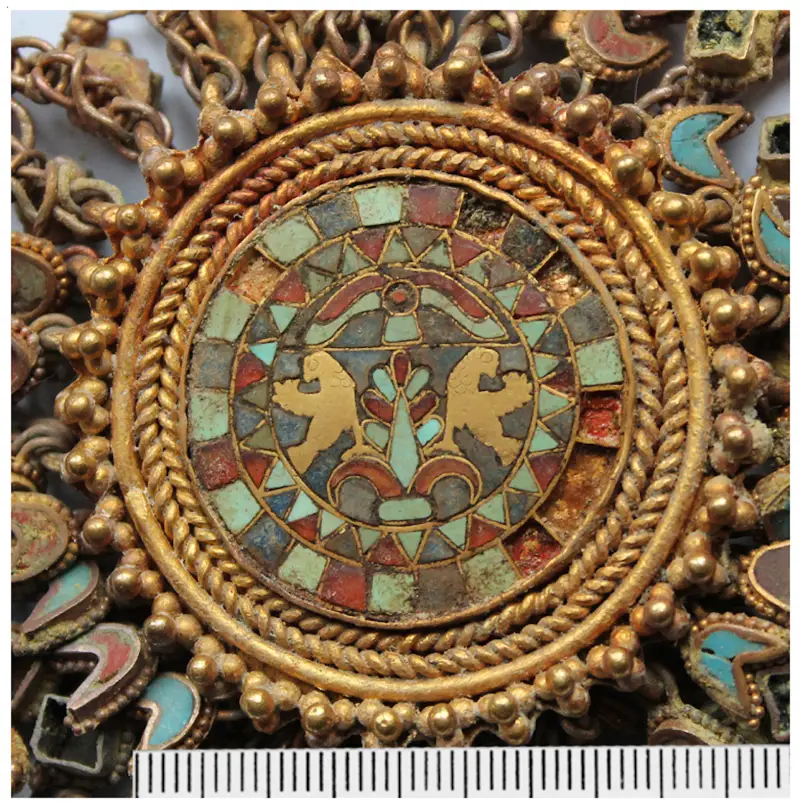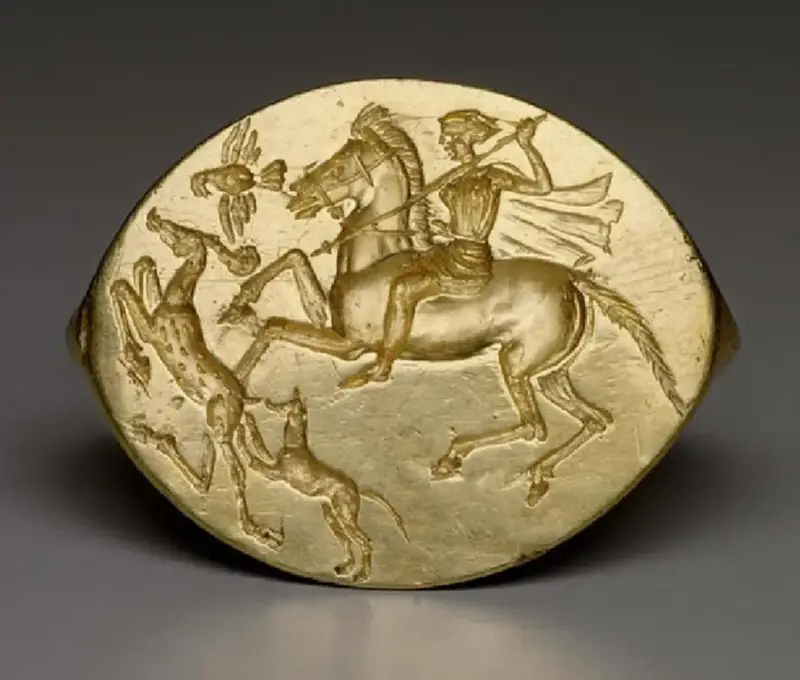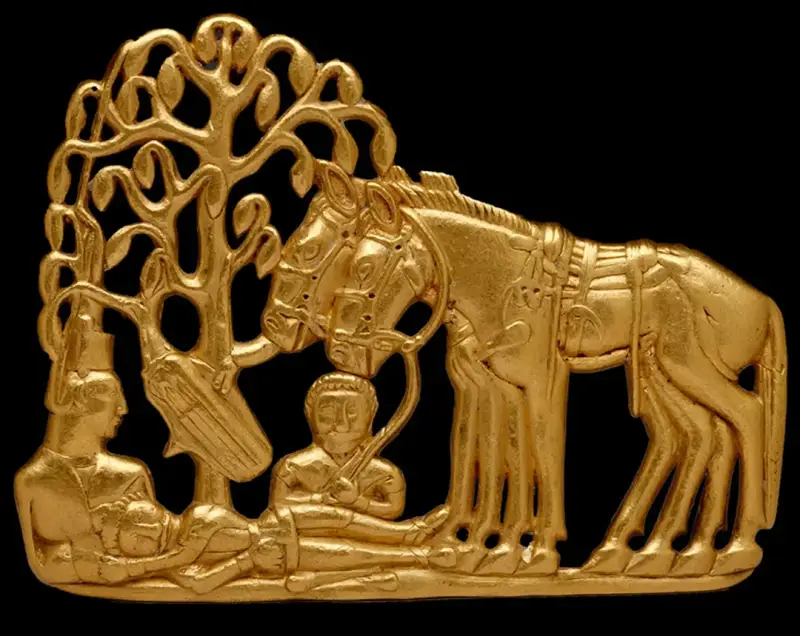Amazons - warriors of Scythia

Fragment of an early Sarmatian medallion from the Filippovsky mound
We will talk about the Amazons, who, most likely, were the ancestors of the Sarmatians - tribes that spread out in the 5th-4th centuries. across the territories of present-day Ukraine, southern Russia, the Caucasian republics, Kazakhstan and China.
VII century BC e.
You find yourself on land east of Ancient Greece. To your right is the Black Sea, to your left is a mountain range. You drive through shallow marshes along the coast, with only the occasional heron, wild horse or hawk crossing your path. When suddenly you are attacked by a squad of ferocious warriors on horseback.
According to the Greek scientist Herodotus, this is exactly what happened to the tribe of Scythians - horse archers who lived on the shores of the Black Sea around the 7th century. BC e. They one day discovered that their horses had been captured. It was only after the youths entered the battle and killed some of the enemies that they realized that their opponents were women. Women warriors called Amazons who "had nothing but weapons and horses." After all, their whole life is devoted to hunting and raids. The young Scythians quickly decided to change tactics. They did not kill their opponents and stopped all further attacks. Instead, Herodotus claimed, they offered themselves for sex.
The Amazons really liked this idea, and soon the two camps merged into one. Men discovered that the language of women could not be learned, but the Amazons mastered the language of men. As soon as they were able to communicate, the Scythians told the Amazons that they would like to return home now. They answered them:
The young people agreed and soon settled in a new place. The descendants of this union were called Sauromatians. Herodotus tells us that
What Herodotus tells us is quite surprising. As we know, at a time when women of Ancient Greece were not even allowed to leave the house on their own, Sauromatian women were equal to men in horse riding, hunting, and fighting from dusk to dawn. Who were these people, and is there any truth to Herodotus' story?

Gold ring depicting a deer hunt, 450-400 AD. BC e. Museum of Fine Arts in Boston
The Sauromatians were part of the Scythians, a Greek term for a variety of culturally similar but distinct nomadic and semi-nomadic communities who lived, rode and fought for centuries in close proximity to ancient Greek settlements in the eastern Aegean. They lived in an area stretching from the Himalayas and Altai Mountains to the Black Sea in what is now Georgia and Turkey. Plato and Herodotus spoke about them, the latter assures us that among some tribes women began to have no less power than men.
More recently, historian Adrienne Mayor has rediscovered these independent warrior women. She traced archaeological and literary traces of the mythical Amazons and identified them as historical doubles of female horse archers of Scythia and Sauromatia, describing their findings in the book “Amazons: Lives and Legends of Women Warriors of the Ancient World.” Fierce, independent female warriors have long been considered merely a figment of the imagination of the ancient Greeks. The evidence Major pieced together tells a different story: these women were real.
The author's findings indicate that women in Scythian societies led a much freer lifestyle than their Greek contemporaries. Girls could grow up to become anything they wanted: a hunter, an artist, a bard, a gardener, a mighty warrior, a heroine, a traveler. At least this is evidenced by the names of these women. The major has compiled an extensive list of female Amazon names, most of which are inscribed on Greek vases. For example: Alkaya – powerful; Heuke – heroine; Euryale - long journeys; Hasa is the one who heads the council.
The hopes that parents in these societies had for their daughters are clear: they wanted them to travel widely, to be political leaders, to be masters of their own destinies. Passivity, modesty, beauty? I think none of these traits were important or valued in women on the Scythian steppes. They left us no written evidence. But their belongings and what we know about them from other cultures with written sources allows us to get an idea of what the life of a female warrior in Scythia might have looked like.
According to Adrienne Mayor, Sauromatian women and men actually formed pairs of two. But they mostly followed an open relationship.
Amazons enjoyed sexual freedom that would have been unthinkable for Greek women.
VI century BC e.
Fast forward to 600 BC. e., the place of action is Scythia. Imagine again that you find yourself in the east of Ancient Greece, just like 100 years ago. I understand that the vast majority of readers here are men. But still, the article is about ancient women, and it will be more clear if you imagine yourself as a woman who has not slept since dawn, hunting game on horseback for herself, her family and friends. Your name is Heuke, your father and mother were sure that you would become one of the heroines of the tribe.
After several hours of riding, you would probably feel a slight irritation between your legs. Your ancestors already invented lined trousers, so the sensations are tolerable. As the writer Major tells us, the ancient Greeks attributed the invention of trousers to barbarian women in the east. It seems true, because they spent most of their lives on horseback. Many Amazons depicted in Greek art wear patterned trousers, tunics, and tall caps.
You are already riding on a bay horse, wearing warm trousers and a long-sleeved woolen tunic decorated with bright green and red zigzag patterns. You are also wearing a tall hat to protect you from the rain. Your clothes cover the tattoos on your arms and legs of all the wild animals you have hunted and or still want to hunt. For example, deer, wild boars and mythical griffins guarding the golden mountains somewhere in the east.
A deer on your right shoulder, a row of dots on your left wrist - you like tattoos. You may have heard about the Greeks living in the west who only tattoo slaves and criminals. What a waste of art! Also, Greeks don't wear trousers at all, or so you've been told. What a completely impractical lifestyle. It’s inconvenient to move quickly, hunt, or fight in a tunic!
Since you've been hunting for several hours and have several birds hanging off your horse, you call out to your companions when you notice a group of tall trees, possibly pine trees. Along with the other huntresses, including your friends and family, your partner, you ride up to the trees and dismount to get some rest. Having removed the magnificent leather and gold quiver, you could sit with your back to the pine trunk, rest your numb legs, looking at yourself in the mirror that you always carry with you. Women and men took care of their beauty - how the braid hangs, how the beard is well-groomed. They were all then buried along with their mirrors.

Scythians with horses under a tree. Part of the belt. Siberia, IV-III centuries. BC e. Hermitage
After the break you return to the hunt. If that's not your thing, you might as well spend the day picking berries and nuts. Or grow vegetables and fruits in small fields together with other women, each of whom has her own field. But the harvest is common.
You return to the settlement. A fire burns in the center and the air is filled with the aroma of roasted poultry seasoned with sage. Hunters and farmers collect the food they find. During dinner, which may consist of meat, fresh berries, goat cheese, honey and nuts, you drink fermented mare's milk. As you continue to drink milk with your friends, you become more and more drunk. Mare's milk may have been used by the Scythians in the same way as diluted wine was used in ancient Greece.
The stars are shining above you. Owls may hoot nearby while the bard takes out his lyre-like instrument and begins to recite the old myth of heroes who cheated death in the guise of a giant. Your daughters sit around the fire, enchanted by the bard, the song and the story. Tomorrow you will go hunting or to the fields again. You will tan leather or make bows and arrows, invent stories, process gold and precious stones, bargain with merchants from Babylon or Egypt.
Information